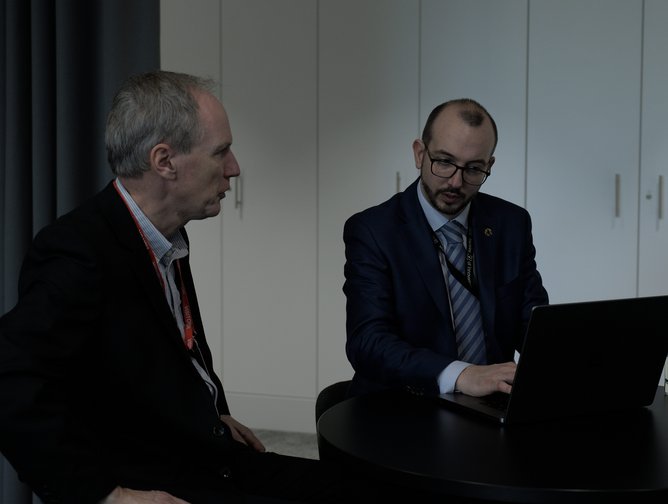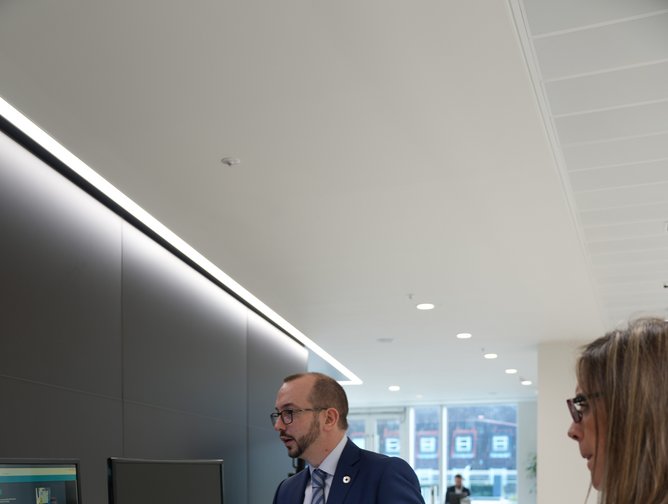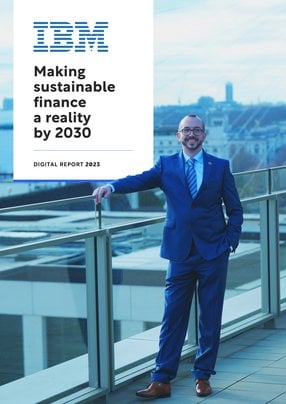“I don't want to sound alarmist, but the world has until 2025 to implement massive changes, ecologically speaking or we’re all going to have a big problem on our hands,” says Adam Thompson, Head of Global Sustainable Finance and ESG for IBM Consulting.
Thompson, who is an expert in data and sustainability, is also, in his spare time, an EU Climate Pact Ambassador – a platform that informs, inspires, and supports climate policies and action in local communities and broader networks.
The British father of three – who currently lives in the Bavarian Forest, Germany, is a passionate advocate for renewable innovations, green technologies, and the transformation of the financial space. From where he’s sitting, accountability is key in driving the change required to prevent climate disaster and mass migration that currently looks imminent if we don’t act NOW!
He says: “In my day job, I work with clients to holistically look at how they embed environmental, social governance, or economic factors into their decision making and how do they operationalise that as part of a transformation for pathways to net-zero, for climate, nature, or indeed how to rebalance society as a whole. The EU Climate Pact is work that I do in my spare time, along with living as self-sustainable as possible. So, I hopefully not just talk the talk, but also walk the walk.
Net zero and the 2030 agenda
Indeed, Thompson, who sees his position more as a vocation than a career, does not describe sustainable finance and ESG merely as trends. “This is a movement – a global, worldwide movement. This is not just about how to apply technology across services. This is really about how we, as one planet and as one society, ensure that we have a planet for the next generation.”
They are powerful words – but ones he stands by. “We need to consider how, in 10, 20 years down the line, the next generation is going to be able to balance their resources. We are on a tightrope, and what’s interesting is that FinTech startups are really beginning to look at nature-based solutions, and these solutions have had incredible exponential growth in a short amount of time by embracing exactly the very solutions that IBM has been speaking about.”
IBM Consulting and the environment
But where does the world’s biggest technology company fit into all this? Well, according to Thompson, it comes down to data, meaningful and accurate communications, and collaborative innovation. He explains that IBM Consulting is the linchpin of the organisation, and that its role is to talk to clients and understand where they are in terms of their ESG and sustainability drives.
“We measure their performance with regards to their own indicators on sustainable finance and how we can actually leverage data as to whether that's from geospatial feeds or whether that's from their own existing data streams they have to date”.
“We normalise and transform that into insights that can be actionable for themselves, for their own clientele, but also ensure that that's competitive and comparable with their other industry incumbents and geos accordingly. We also work with our technology partners here in IBM as well as our ecosystem partners, where we have really leading edge and specific requirements, putting our IBM research and quantum into freight so we can actually provide new innovative solutions with regards to ESG and sustainable finance.”
For Thompson, it's not just a job but a role that he embraces with zeal. “I also try to share knowledge and experiences as to how we can all make an impact individually with regards to climate; how we can all be more self-sufficient in our daily lives and make less waste, but actually be more circular and regenerative in our day-to-day activities.”
Circularity is a key part of the research and development IBM Consulting is concentrating on. The concept focuses on business accountability, from production, to supply chains to the customer, and then to the recycling of products once they have been discarded. This is key in circumventing the ‘throwaway’ nature of the current industrial business systems that sees millions of tonnes of waste being dumped into the environment rather than managed sustainably.
Sustainable finance and ESG
But the definition of sustainable finance and its place within ESG isn’t always immediately clear. This is, in fact, a point that Thompson is keen to clarify.
“Sustainable Finance is really an umbrella regarding embedding ESG into any of the decision making and insights. At IBM, we also provide data curation accelerators to support the embedding of ESG into decision flows. Indeed, we also provide analytical suites regarding big data and new data sets that organisations might not necessarily have to date, for example whether its measuring biomass in nature, or societal impacts and related ecosystem services.
“We actually provide that as an end-to-end data stream so that when you actually want to create new value add or products for your own services or for your own clientele, you can then also containerise them, easing consumability accordingly.”
Our Consulting Sustainability Services approach also enables clients to co-innovate by scaling to other use cases. Such as “Key focus themes of Climate-first but not Climate-Only, with for example the 30/30 agreement from COP15 etc. Or, indeed if you wanted to do something that's completely nuanced, such as nature-based solutions such as engineered reefs, we would support organisations from an IBM garage co-creation all the way through to the solution that you can then assetize that and actually sell that as a service, as well as having it recognized on your balance sheet – a true sustainable transition”
Sustainability and timelines
With such strict goals regarding timelines and creating more sustainable financial systems globally, the work is challenging. Thompson explains that the ideal transition into sustainable finance needs more progress and catalysts. In recent times various geopolitical factors and energy crises as well as certain corporations’ unwillingness to genuinely embrace the ESG agenda has slowed the ESG momentum. He speaks about the green asset ratio (GAR) and what that currently means in relation to assets being categorised as “green” by the EU taxonomy for Europe.
For GAR “Right now, organisations might find that they're in single digits in terms of percentage points, which will be quite normal as we're both on a transition journey, and there is diverging scope and value between the various financial institutions structures. But that said, what would ‘Good’ look like? Well, for most organisations, by 2025 to 2030, ‘Good’ needs to look like most organisations starting to be at the minimum 50% mark and above, to show true transitional improvements.”
Despite the challenging outlook for many companies to reach their needed sustainability commitments, Thompson is optimistic that technology and co-innovation are the accelerators to make those aims a reality. “When you realise it's only Europe that we might get up to 25% of renewables by the end of the year, then compared to where we originally started in the early 2000’s we were still in single digits, then there's definitely the ability to transform. Capital, ironically, is not the challenge. The challenge is to put the capital to those projects, which would actually contribute to meaningful change and support for example the achieving Europe’s Fit for 55 Target of 40% renewable energy by 2030”.
“And this isn't just about a tick box exercise; this is really looking at it holistically by saying to clients, ‘If you want to invest in wind turbines or if you want to invest in solar power farms, that's great, but you also need to look at some of the other green elements beyond climate and secularity, for example, about societal impact’ etc.”
Thompson says that having a more transparent landscape regarding the implementation of sustainable finance and ESG will act as a catalyst for greater adoption of practices and that ESG risk ratings require more oversight ref the granularity of good quality primary datasets to ensure all corporations are working towards impactful ratings and consequently investments.
“ESG risk ratings have been very diverse. In that level of granularity, it's been ranging from the 50 to 100 mark, through to 300, depending on which rating agency has been leveraged. That's going to be the next one where this secondary data source – which has been good in front or perfect for the last number of years – will change.”
“More importantly, it'll provide that holistic, quadruple bottom line that the people, planet, prosperity, and purpose lens for the consumer can be included in.”
He continues: “Some organisations talk about ESGI [Environmental Social Governance Impact] – that quadruple bottom line is intrinsic and linked to our UN SDGs. It's not just about making a return on investment over five or 10 years. It’s about having something that's regenerative, that has a positive impact on society.
“But when it comes to the industry as a whole, I think we’re at a crossroads. You have those who are really embracing sustainable finance – based on my own dialogue with institutions, this certainly happens in Europe a lot more than in the US to date.
“Potentially once we have clarity on the US Security Exchange Commission in terms of regulations, this dynamic might change. But right now, it has been regulatory driven. But what is also clear generation-wise, from a consumer spending perspective, this is also changing the trend and the focus of ESG adoption.”
Digital partners driving the ESG movement.
IBM is naturally not alone in its efforts to deliver this ESG message and works with a wide network of technology giants globally to innovate and deliver new products, services, and ideas within the ESG and sustainable finance markets, including AWS, Celonis, Microsoft, Oracle Salesforce, SAP, Workday.
“If we're talking sustainability performance management, a lot of corporations obviously have a book of record. So, with our Partners SAP, Oracle and Workday, absolutely we will work hand in glove together, and we complement one another, whether it be embracing their integrated sustainability software capabilities, or a co-innovation of new assets, or indeed where we take some of our own sustainability software portfolio offerings such as Envizi to provide a holistic solution jointly to our clients.
“In terms of the social element, we work market-leading companies such as FRDM, where we actually look at the whole end-to-end value chain and environmental factors, but also take into account a multitude of social factors from employee welfare, diversity and inclusion, and working conditions for all those from tier one to tier X suppliers.”
However, he points out that despite the advantages of the digital ecosystem, and the advances IBM Consulting has made, many challenges still exist because technology stacks aren’t standardised across the board. “When you're talking about other platform providers, we have alliances, but we also leverage their platforms. So, it will never be one size fits all.
The future of sustainable finance
Thompson is keen to emphasize that, despite the broad technocratic processes involved with the implementation of ESG regulations, it is ultimately all about serving humanity more effectively, as well as preserving the environment.
“First off, we already have goals in place that we don't leave anybody behind – the 17 UN SDG (sustainable development goals) make that very clear.
“For myself, I would like to see that we don't just act as the torch-bearers, but we actually take more accountability than we do today, in terms of when we make financial investments, and that we ensure that it's not just during the light power, but beyond.” Here is the need of Life-Cycle Investing and Circularity Transition Indicators as part of Financial Investing.
Circularity in terms of production, use, and recycling, is key. “It's more about becoming attuned to the needs of both the industry but also the needs of the planet, as we are going through this sustainable transition. And I can see innovation playing a fundamental role in the creation of more secondary markets for further recycled and repurposed materials too. But it's ultimately a collaborative dialogue because we all have a role to play from design to consumption to regeneration – both at a corporate and individual level.”
Furthermore, Thompson explains that whilst COP27 and COP15 have played a vital role in addressing the needs of the planet as we move forward, time is of the essence. “The timeline for required change is actually lower than 2025. You realise very quickly that there will be a domino effect from nature and in terms of biodiversity, degradation, water scarcity, and obviously climate change itself in terms of the temperature rises and consequently climate human migration as a result”.
He concludes: “It's fundamental to everyone's livelihood that we address this. And sustainable finance is absolutely key in playing that by channeling funds and investments in the right direction to make impactful change. But it's very clear that the runway that we all have to address this is shortening. We need to take action now for the foreseeable future.”






